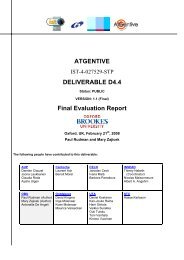pdf 820Kb - INSEAD CALT
pdf 820Kb - INSEAD CALT
pdf 820Kb - INSEAD CALT
Create successful ePaper yourself
Turn your PDF publications into a flip-book with our unique Google optimized e-Paper software.
Evaluation report of the use of Onto-Logging<br />
platform in the user site<br />
Deliverable ID: D8b<br />
Page : 9 of 110<br />
Version: 1.0<br />
Date: 27 january 2004<br />
Status: Final<br />
Confid.: Public<br />
However, the importance of user’s perception should not be underestimated, since, it<br />
contributes to the motivation of the user, which can be considered very important for the<br />
adoption any radically new system.<br />
The elements that can be evaluated at this level include the user -friendliness of the system,<br />
and the perceived value and limitation that the user gets from the system, or level of<br />
interactivity. The table 1 summarize the different levels of evaluation.<br />
Level 2: Assessment: Do the approach/system function? This level reflects the richness &<br />
the completeness of the functionalities of the system. In particular, it covers elements such as<br />
the ability to conduct a full session of the system, the number of functions available, and how<br />
deep the system support the user’s activities.<br />
Level 3: Transfer: Is the approach/system used? This level reflects the adoption of the<br />
system in an operational context (beyond the testing). In particular, it covers elements such as<br />
the adoption of the approach/system by an organization, and also clarifies the context of use.<br />
Indicators may include the number of installation effectively used in the organization, the<br />
number of activities supported for the organization, the features adopted by the use, and the<br />
rate of growth of new installation.<br />
Level 4: Impact: Measures the impact on the organization. This level reflects the<br />
substantive value of the approach/system for the organization, and for the people that use it.<br />
Indicators of impact include: improved work productivity, better work quality, faster result,<br />
and cognitive / behavioural transformation of the users leading to an organization better<br />
adapted to its environment.<br />
Level 5: Do the approach/system performs economically well? This level is concerned<br />
with the evaluation of the system according to a market perspective, and in particular its<br />
capability to be exploited in a competitive environment. Indicators include the cost of<br />
acquisition and the cost of ownership of the solution.<br />
It is important to remind that users organizations are ultimately driven by results & therefore<br />
should mainly be interested by level 4 (Impact on the Organization), and in particular to the<br />
answer to the following questions: (1) Is the proposed approach & system delivers<br />
substantive value to the organization that is translated into improved flexibility and better<br />
adequation to the company needs? (2) What are the key elements of this approach & system<br />
that contribute the most to the impact, and what is the nature of their contribution? However,<br />
Level 4 cannot easily be measured, and the answer to these questions can mainly be observed<br />
in the long run.<br />
The evaluation of Level 2 (assessment) provides a useful perspective: It reflects the level of<br />
functionalities delivered by the approach & system. However, this level can definitively not<br />
be considered sufficient since it only provide a partial picture that do not take into account the<br />
meaningfulness & usefulness of the approach and of the system. For instance, we can very<br />
well imagine systems (and actually, this applies to most approaches & systems which design
















